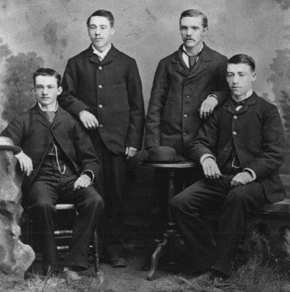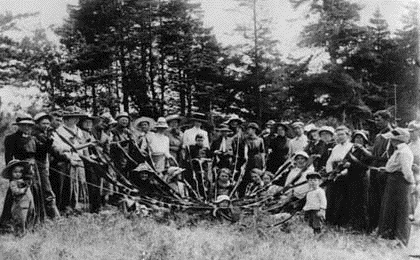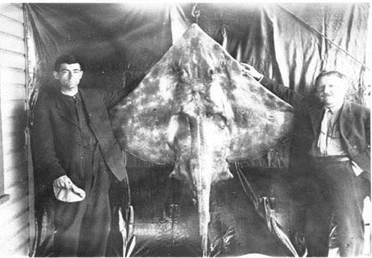
A History of University of Washington's Research Station on San Juan Island
For over one hundred years University of Washington's Friday Harbor Laboratories have served the scientific community as a highly respected field station for research in marine ecology, zoology, developmental biology, genetics, and many other fields of biological science. They also provide important training for new scientists through intensive courses for graduate and advanced undergraduate students.
Friday Harbor Laboratories is a state-of -the-art marine research facility today, with ten laboratories and over one thousand five hundred acres of biological preserves in Washington's beautiful San Juan Islands. But it was not always so.
From humble origins over a century ago, labs have had a long history. Their story begins with a small group of young people who shared a passionate interest in natural history and the marine sciences.
1894: The Young Naturalists' SocietyIn the latter half of the nineteenth century, a group of young men, sons of the area's original settlers, created a society whose mission was to learn about the waters of the San Juan islands. Led by O.B. Johnson, a professor at the University of Washington, the group studied the natural history of the region and began collecting and identifying local fauna. Then, in 1894, with some of the group leaving for other areas, the remaining members voted to donate their collection to the University of Washington. In this way they founded the University's first collection of marine specimens. 1896: The marine camp at Port TownsendIn 1896 the Young Naturalists' Society received a small sum of money from the University of Washington, with which they established a permanent camp in Port Townsend. Besides the Young Naturalists, this camp was also used regularly by Columbia University. |
 |
||
The University of Washington was slow to realize the potential for marine research in the area. It took pressure from Zoology professor Trevor Kincaid, a former member of the Young Naturalists, and from researchers at the University if Minnesota to finally convince the University of Washington to establish a marine field station. In 1903, Kincaid chose a site near Friday Harbor, and in the summer of 1904 the new station held its first classes. For a brief time the marine station was housed in an old fish cannery in the town of Friday Harbor, but later returned to its former camp site.
1910 - 1923: Puget Sound Biological StationIn 1910, Mr. Andrew Newhall donated four acres of waterfront land, just south of Friday Harbor to build a permanent research station. Professor Kincaid was named its director, and through his leadership the station reached class enrollments of 70 students by 1914. |
|||
 |
In 1914 Dr. T. C. Frye became director, a tenure that lasted until 1930. As the number of students and researchers grew, it became clear that the original site was not adequate for the growing facility. An active search began for land to relocate the laboratories. In 1921 Dr. Fyre convinced the US government to donate its marine station at Point Caution. US President Harding himself formalized the transaction through a letter which is still on display at the Friday Harbor Labs. | ||
1923 - PresentThe labs moved onto their current site at Point Caution in 1923. The site consists of 484 acres of land including over two miles of shoreline. By 1924 the facilities included two laboratory buildings, a dining hall, and a curator's cottage. In 1925 two more laboratories were built. In 1930 the station came under the control of the University of Washington's new Oceanography department, and its name changed to the University of Washington Oceanographic Laboratories. Along with this change also came a shift in purpose, toward the training of professional researchers and scientists, and away from training biology teachers. During the war years, the labs were used by the US Marines as a training facility, returning to to normal operation in 1947. In 1951 the labs received their final name change, to the present Friday Harbor Laboratories. |
|||
Professor Trevor Kincaid and Collegue, with Great Skate |
Students at work in FHL classrooms |
||
Life in the early days of the Marine Station on San Juan Island
Today students and researchers alike find a range of comfortable accommodations, from dormitories to cabins and apartments and a cafeteria which offers delicious, varied meals---a contrast to the more humble beginnings. Some things have changed, but surprisingly, many have remained the same.
The following are exerpts from an 1930 article describing life at the
Puget Sound Biological Station by Lyman D. Phifer and Margaret W. Phifer.
The article appeared in "The Biologist," Volume 7, September
1930.
Life at the Station is simple and enjoyable. Strong reasons for this
are the invigorating atmosphere and beautiful natural surroundings, for
the weather is freshly mild and clear. Usually there is a little rain
during the first part of the session but this merely adds variety to
otherwise clear skies. It all inspires one with a joy of life, a deep
breathing of new vigor after the stench of cities and heated winter houses.
On shore, everywhere are tall green trees; off shore, everywhere green-blue
sea - trees which bend and sigh in the winds, waters that rise and sink
back in unceasing murmur. Looking across San Juan to the west one sees
the great Olympics; far away to the east rise the cold blue Cascades,
Mount Baker surmounting them in majestic grandeur.
It seems only fitting that in such surroundings living should be simple and
free. Everyone lives in 10 x 12 tents that easily provide for two persons (if
neither brings more clothes than are necessary). Suitcases can readily be pushed
under the beds, but a trunk is space taking. Clothes vary; lately there has
been a craze for overalls, but knickers are still attractive too. Besides these,
however, shirts or blouses, a heavy sweater, boots and tennis shoes are needed,
and one is quite prepared for whatever comes. Sometimes the girls feel the
need of a change, in which case a gingham dress or two suffices. There simply
isn't time to spend on dressing , and of course tents are notoriously poor
places to keep good clothes. Also, the class work requires clothing suitable
for field and water going and one is in class most of the day. But the strongest
argument for simplicity is the laundering. Almost everyone does his own - at
the community wash tubs, and in the ironing tent, where electric irons are
provided. Saturday is indeed the big cleaning day.
And so the Phifers' description continues, painting a picture of life at the labs in the 1930's. Through their stories it becomes clear that the heart and soul of the marine station was a fascination with the natural world -- of the San Juan Archipelago and beyond, a mission which is still central to life today at the Friday Harbor Labs.

Staff and student portrait, with Bull Kelp

